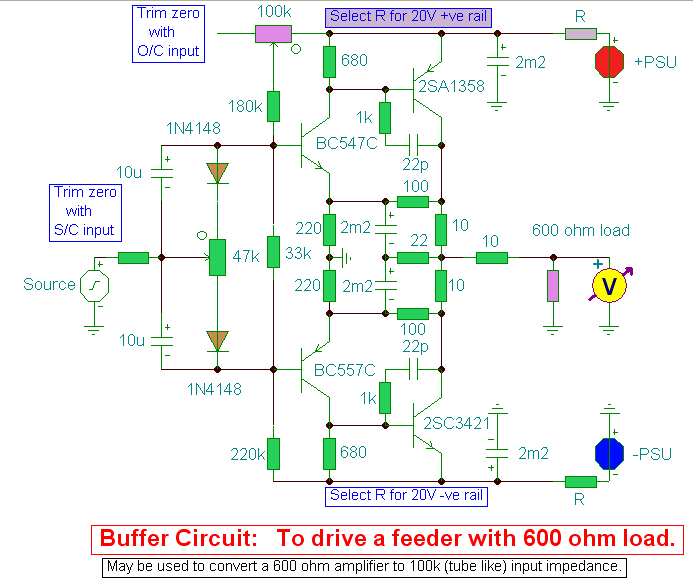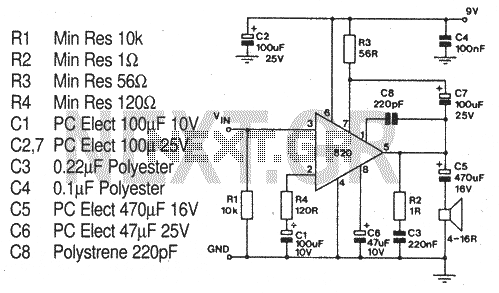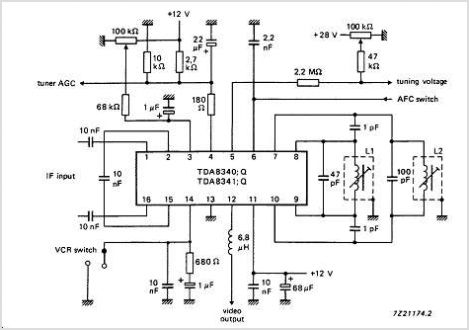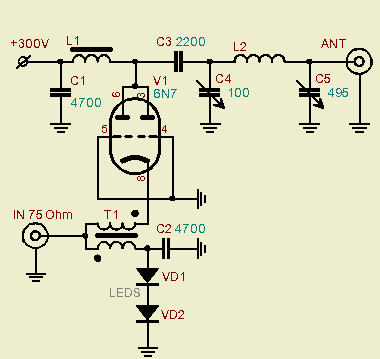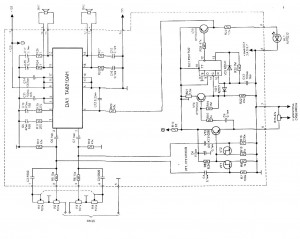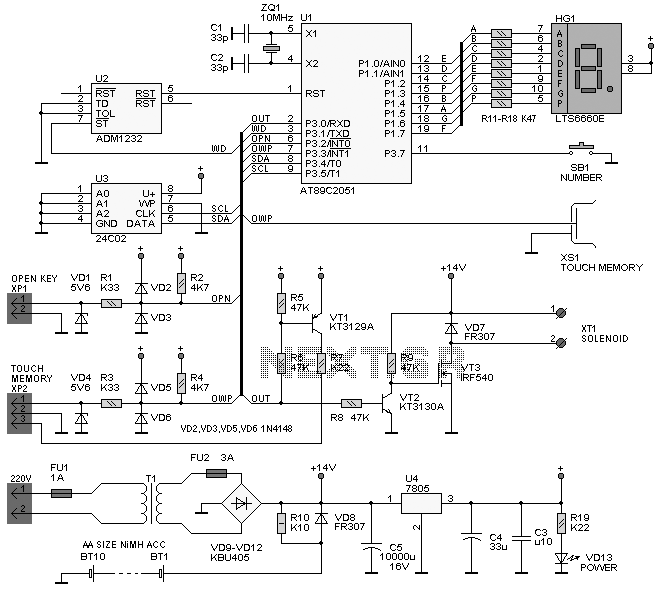
Intro to Intan Amplifier Chips
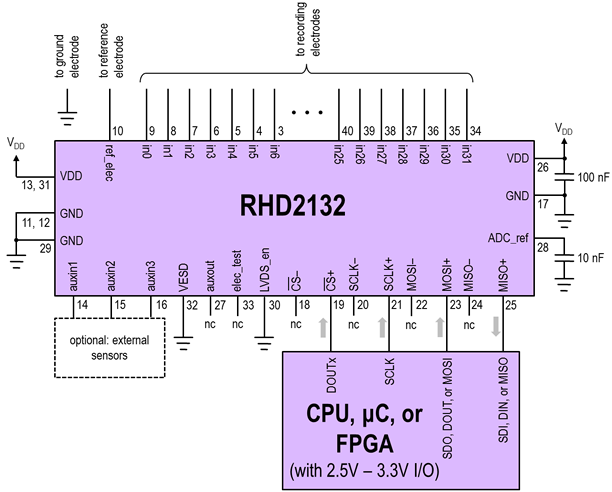
The Intan Technologies RHA2116 is a 16-channel integrated amplifier array that requires only three external resistors to set the amplifier bandwidth, two capacitors for power supply smoothing, and occupies one square centimeter of board area. The digital-output and analog-output amplifier chips from Intan Technologies are compact, low-power silicon devices that replace traditional modules found in electrophysiological recording systems. Intan amplifiers feature high input impedances exceeding 10 megohms at 1 kHz, allowing direct connection of high-impedance electrodes to the chips. Proprietary low-noise circuits achieve an input-referred RMS noise level of approximately 2 microvolts, enabling resolution of small physiological signals. The tiny AC signals from physiological electrodes are typically accompanied by large DC offsets that drift over time. To mitigate this, Intan amplifiers incorporate high-pass filters on each channel to block significant DC potentials and low-frequency drift or artifacts, with configurable cutoff frequencies. Biopotential signals need to be amplified from the microvolt range to the volt range to match the input range of high-resolution A/D converters. Intan amplifiers provide suitable gain for observing signals up to +/-5 mV with sub-microvolt resolution using modern A/D converters. Differential amplifiers must also demonstrate good common-mode noise rejection. A low-pass filter is essential prior to sampling and digitization to limit the bandwidth of each amplifier and prevent aliasing, with the option to attenuate undesirable high-frequency signals or artifacts. Each channel of Intan amplifiers features 3rd-order Butterworth low-pass filters with configurable cutoff frequencies. The chips contain multiple amplifier channels to promote device miniaturization, with signals from an array of amplifiers multiplexed to a single output pin, allowing all channels to share a single A/D converter. Simple digital control lines manage the sequencing of channel selection, enabling access to multiple electrodes with minimal control and data lines. Intan chips facilitate in situ measurement of electrode impedances by routing an AC test current to any selected electrode, with the resulting voltage amplitude measured by the on-chip amplifiers to calculate impedance. The RHD2000 line of chips integrates on-chip 16-bit A/D converters controlled by a standard serial peripheral interface (SPI) bus, transforming weak electrode signals into a digital data stream and replacing analog instrumentation and data conversion circuitry in electrophysiology monitoring systems. A basic schematic for a 32-channel recording system using an Intan Technologies RHD2132 digital electrophysiology interface chip is provided. Two small capacitors are the only additional components required. Four digital signals form an industry-standard SPI bus for sending commands to the chip and receiving data. On-chip registers are used to set the amplifier bandwidth. The diagram illustrates the modules of a typical electrophysiology recording system, with interactive elements for additional information on amplifier stages. All functions are handled by a single RHD2000-series Intan amplifier chip. The system depicted features unipolar recording electrodes and a common reference electrode, supported by the RHA2116 and RHA/RHD2132 16- and 32-channel amplifier chips. For certain applications, such as external EMG, the use of independent bipolar electrodes for each amplifier channel may enhance common-mode interference rejection, supported by the RHA/RHD2216 16-channel amplifier chip.
The RHA2116 integrated amplifier array is designed for high-performance electrophysiological recording applications. Its compact design allows for efficient use of board space while maintaining excellent performance characteristics. The high input impedance ensures that the integrity of the physiological signals is preserved, which is crucial for accurate measurements. The proprietary low-noise circuitry minimizes noise interference, allowing for the detection of small signals that are often lost in traditional systems.
The configurable high-pass and low-pass filters provide flexibility in signal processing, accommodating various experimental needs and ensuring that only the relevant frequency components are amplified. This capability is essential in applications where specific signal frequencies must be isolated from noise and drift.
The multiplexing of signals from multiple amplifier channels to a single output pin is a significant advantage, simplifying the design of the data acquisition system and reducing the number of required connections. This feature, combined with the SPI bus for digital communication, enhances the overall system integration and reliability.
Additionally, the ability to perform in situ impedance measurements is a valuable tool for researchers, enabling them to assess electrode performance and ensure optimal signal quality during experiments. The integration of 16-bit A/D converters directly on the chip streamlines the signal processing chain, reducing the need for external components and improving the robustness of the system.
Overall, the RHA2116 and its associated technologies represent a significant advancement in the field of electrophysiology, providing researchers with powerful tools for high-resolution signal acquisition and analysis in a compact and efficient package.The Intan Technologies RHA2116 16-channel integrated amplifier array requires only three external resistors (to set amplifier bandwidth), two capacitors (to smooth power supply), and one square centimeter of board area. Intan Technologies digital-output and analog-output amplifier chips are small, low-power silicon devices that replace the followi
ng modules found in traditional electrophysiological recording systems: Intan amplifiers have high input impedances (more than 10 megohms at 1 kHz), so high-impedance electrodes may be connected directly to the chips. The amplifiers use proprietary low-noise circuits to achieve an input-referred RMS noise level of approximately 2 microvolts, allowing small physiological signals to be resolved.
The tiny AC signals acquired by physiological electrodes are usually accompanied by relatively large DC offsets that drift slowly with time. Intan amplifiers incorporate high-pass filters on each channel to block large DC potentials and undesirable low-frequency drift or artifacts.
The cutoff frequency of these filters is configurable over a wide range. Biopotential signals must be amplified (relative to a reference electrode or negative electrode) from the microvolt level to the volt level to match the full input range of high-resolution A/D converters. Intan amplifiers provide suitable gain for observing signals up to +/-5 mV in amplitude with sub-microvolt resolution using modern A/D converters.
Differential amplifiers should also have good rejection of common-mode noise. Prior to sampling and digitization, a low-pass filter must be used to limit the bandwidth of each amplifier and prevent aliasing. Additionally, this filter may be used to attenuate undesirable high-frequency signals or artifacts. Intan amplifiers incorporate 3rd-order Butterworth low-pass filters on each channel. The cutoff frequency of these filters is configurable over a wide range. Intan chips contain many amplifier channels to facilitate device miniaturization. The signals from an array of amplifiers are multiplexed to a single output pin so that all channels can share a single A/D converter.
Simple digital control lines are used to sequence the selection of channels. This allows many electrodes to be accessed using a small number of control and data lines. Intan chips facilitate the in situ measurement of electrode impedances by allowing an AC test current to be routed to any selected electrode. The resulting voltage amplitude (measured using the on-chip amplifiers) can be used to calculate impedance.
The new RHD2000 line of chips incorporates on-chip 16-bit A/D converters controlled by a standard serial peripheral interface (SPI) bus. A single RHD2000 chip transforms weak electrode signals directly into a digital data stream, replacing all the analog instrumentation and data conversion circuitry in electrophysiology monitoring systems.
A basic schematic for a 32-channel recording system using an Intan Technologies RHD2132 digital electrophysiology interface chip is shown below. Two small capacitors are the only extra components required. Four digital signals comprise an industry-standard SPI bus that is used to send commands to the chip and receive data.
On-chip registers set the amplifier bandwidth. The diagram below shows the modules of a typical electrophysiology recording system. Mouse over the amplifier stages for more information. All of these functions are performed by a single RHD2000-series Intan amplifier chip. The diagram above depicts a system with unipolar recording electrodes and a common reference electrode. The RHA2116 and RHA/RHD2132 16- and 32-channel amplifier chips support this architecture. For some applications (e. g. , external EMG), it may be desirable to use independent bipolar electrodes for each amplifier channel to enhance the rejection of common-mode interference.
The RHA/RHD2216 16-channel amplifier chip supports this architec 🔗 External reference
The RHA2116 integrated amplifier array is designed for high-performance electrophysiological recording applications. Its compact design allows for efficient use of board space while maintaining excellent performance characteristics. The high input impedance ensures that the integrity of the physiological signals is preserved, which is crucial for accurate measurements. The proprietary low-noise circuitry minimizes noise interference, allowing for the detection of small signals that are often lost in traditional systems.
The configurable high-pass and low-pass filters provide flexibility in signal processing, accommodating various experimental needs and ensuring that only the relevant frequency components are amplified. This capability is essential in applications where specific signal frequencies must be isolated from noise and drift.
The multiplexing of signals from multiple amplifier channels to a single output pin is a significant advantage, simplifying the design of the data acquisition system and reducing the number of required connections. This feature, combined with the SPI bus for digital communication, enhances the overall system integration and reliability.
Additionally, the ability to perform in situ impedance measurements is a valuable tool for researchers, enabling them to assess electrode performance and ensure optimal signal quality during experiments. The integration of 16-bit A/D converters directly on the chip streamlines the signal processing chain, reducing the need for external components and improving the robustness of the system.
Overall, the RHA2116 and its associated technologies represent a significant advancement in the field of electrophysiology, providing researchers with powerful tools for high-resolution signal acquisition and analysis in a compact and efficient package.The Intan Technologies RHA2116 16-channel integrated amplifier array requires only three external resistors (to set amplifier bandwidth), two capacitors (to smooth power supply), and one square centimeter of board area. Intan Technologies digital-output and analog-output amplifier chips are small, low-power silicon devices that replace the followi
ng modules found in traditional electrophysiological recording systems: Intan amplifiers have high input impedances (more than 10 megohms at 1 kHz), so high-impedance electrodes may be connected directly to the chips. The amplifiers use proprietary low-noise circuits to achieve an input-referred RMS noise level of approximately 2 microvolts, allowing small physiological signals to be resolved.
The tiny AC signals acquired by physiological electrodes are usually accompanied by relatively large DC offsets that drift slowly with time. Intan amplifiers incorporate high-pass filters on each channel to block large DC potentials and undesirable low-frequency drift or artifacts.
The cutoff frequency of these filters is configurable over a wide range. Biopotential signals must be amplified (relative to a reference electrode or negative electrode) from the microvolt level to the volt level to match the full input range of high-resolution A/D converters. Intan amplifiers provide suitable gain for observing signals up to +/-5 mV in amplitude with sub-microvolt resolution using modern A/D converters.
Differential amplifiers should also have good rejection of common-mode noise. Prior to sampling and digitization, a low-pass filter must be used to limit the bandwidth of each amplifier and prevent aliasing. Additionally, this filter may be used to attenuate undesirable high-frequency signals or artifacts. Intan amplifiers incorporate 3rd-order Butterworth low-pass filters on each channel. The cutoff frequency of these filters is configurable over a wide range. Intan chips contain many amplifier channels to facilitate device miniaturization. The signals from an array of amplifiers are multiplexed to a single output pin so that all channels can share a single A/D converter.
Simple digital control lines are used to sequence the selection of channels. This allows many electrodes to be accessed using a small number of control and data lines. Intan chips facilitate the in situ measurement of electrode impedances by allowing an AC test current to be routed to any selected electrode. The resulting voltage amplitude (measured using the on-chip amplifiers) can be used to calculate impedance.
The new RHD2000 line of chips incorporates on-chip 16-bit A/D converters controlled by a standard serial peripheral interface (SPI) bus. A single RHD2000 chip transforms weak electrode signals directly into a digital data stream, replacing all the analog instrumentation and data conversion circuitry in electrophysiology monitoring systems.
A basic schematic for a 32-channel recording system using an Intan Technologies RHD2132 digital electrophysiology interface chip is shown below. Two small capacitors are the only extra components required. Four digital signals comprise an industry-standard SPI bus that is used to send commands to the chip and receive data.
On-chip registers set the amplifier bandwidth. The diagram below shows the modules of a typical electrophysiology recording system. Mouse over the amplifier stages for more information. All of these functions are performed by a single RHD2000-series Intan amplifier chip. The diagram above depicts a system with unipolar recording electrodes and a common reference electrode. The RHA2116 and RHA/RHD2132 16- and 32-channel amplifier chips support this architecture. For some applications (e. g. , external EMG), it may be desirable to use independent bipolar electrodes for each amplifier channel to enhance the rejection of common-mode interference.
The RHA/RHD2216 16-channel amplifier chip supports this architec 🔗 External reference
